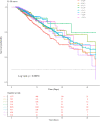Influence of fluid balance on the prognosis of patients with sepsis
- PMID: 34740312
- PMCID: PMC8569078
- DOI: 10.1186/s12871-021-01489-1
Influence of fluid balance on the prognosis of patients with sepsis
Abstract
Background: Early and timely fluid treatment or resuscitation are the basic measures for the active treatment of sepsis. Our aim is to further explore the relationship between fluid balance and prognosis in patients with sepsis on a daily basis for 5 days.
Methods: Sepsis patients in eICU Collaborative Research Database were divided into the negative balance group (NB/-) and the positive balance group (PB/+) according to daily fluid balance. The primary outcome was in-hospital mortality. Survival differences between the groups were analyzed by using Cox regression. Then dose-response relationship between fluid balance and in-hospital mortality was studied using restricted cubic splines (RCSs). Furthermore, patients with fluid balance data for the previous three consecutive days were selected and divided into eight groups ("+/+/+", "+/+/-", "+/ -/-", "+/ -/+", "-/ -/-", "-/ -/+", "-/+/+", and "-/+/-"). Kaplan-Meier curves and Cox regression were used to show the survival difference between groups.
Results: Our study, which included 19,557 patients in a multicenter database, showed that positive fluid balances on days 1, 2, and 3 after sepsis diagnosis were associated with poor prognosis with the HRs of 1.29 (1.20,1.40), 1.13 (1.01,1.27), and 1.25 (1.08,1.44), respectively, while the fluid balance on days 4 and 5 had no effect on the primary outcome. Then RCSs showed an overall trend that the risk of in-hospital mortality on days 1, 2, and 3 increased with increasing fluid balance. For three consecutive days of fluid balance, we studied 9205 patients and Kaplan-Meier curves revealed survival differences among patients in the eight groups. The cox model demonstrated that compared with the "+/+/+" group, the "+/ -/-", "-/ -/-", "-/ -/+", "-/+/+", and "-/+/-" groups had a lower risk of in-hospital mortality, with HRs of 0.65 (0.45,0.93), 0.72 (0.60,0.86), 0.63 (0.43,0.93), 0.69 (0.48,0.98), and 0.63 (0.42,0.96), respectively.
Conclusions: In patients with sepsis, positive fluid balance on days 1, 2, and 3 was associated with adverse outcomes. For patients with fluid balance for three consecutive days, the "+/-/-", "-/ -/-", "-/-/+", "-/+/+", and "-/+/-" groups were less likely to die in hospital than the "+/+/+" group.
Keywords: Fluid balance; Prognosis; eICU-CRD; sepsis.
© 2021. The Author(s).
Conflict of interest statement
The authors declare that they have no competing interests.
Figures





References
Publication types
MeSH terms
LinkOut - more resources
Full Text Sources
Medical

